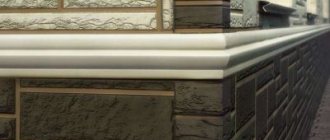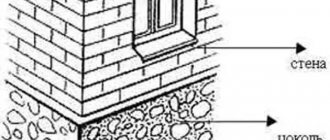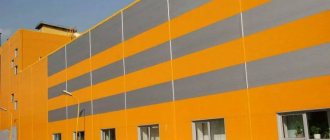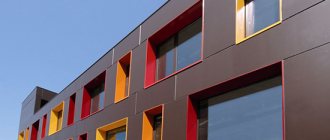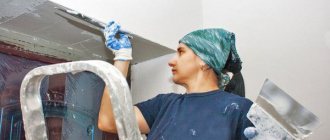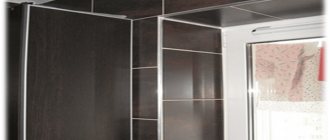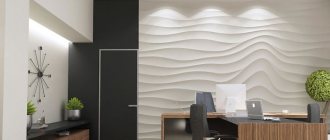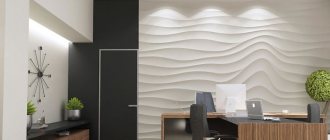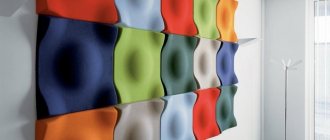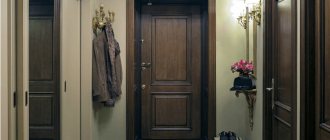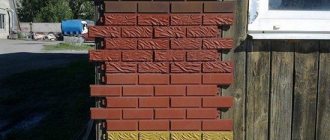SHARE ON SOCIAL NETWORKS
FacebookTwitterOkGoogle+PinterestVk
Installation of a metal-plastic system is not the final stage of the window replacement process. To prevent freezing and condensation, the walls of the window opening are finished. Today, sandwich panels for slopes have proven themselves to be the best, characterized by excellent technical and performance qualities and ease of installation. You can learn more about this building material from the article.
Slopes on windows protect against condensation and resist freezing
What are window slopes: the purpose of the structural element
The first step is to understand what slopes are and what their main purpose is. This structural element of a window opening is the inner wall of a niche surrounding the window frame on both sides. Installing a window profile is not the final stage. For a presentable appearance of the window system, it is necessary to install good fittings for PVC windows. It includes not only handles, mechanisms and hinges. The range of elements also includes window slopes, which are used to design the profile.
Slopes provide additional protection of the room from atmospheric influences
Important! It is imperative to finish the slopes to eliminate the occurrence of many negative factors that will negatively affect the appearance, service life of the window system and the microclimate of the room.
Finishing the niche will prevent the accumulation of condensation and freezing of the window frame. It can protect the seams between the frame and the window opening from destruction, so it is important to carry out both internal and external cladding of slopes. Protecting niches can improve the thermal insulation properties of a room, preventing cold outdoor masses from penetrating inside and thermal energy from escaping outside.
Important! Window slopes are also a decorative design of a window system.
To finish the slopes, you can perform plastering, covering the surface with plasterboard, plastic panels. The most popular and least labor-intensive method today is the use of sandwich panels for slopes. This material not only gives the window a finished appearance, but also, thanks to the presence of internal insulation, provides a warm temperature regime in the room.
In addition, window slopes perform a decorative function.
When covering slopes with plasterboard, a large consumption of material will be required, which is associated with its fragility. Plastering the side elements is a labor-intensive and time-consuming process that requires certain skills to ultimately achieve a smooth surface. In addition, such work is associated with significant pollution of the surrounding space.
Helpful advice! The combination of windows and slopes made of the same material looks most harmonious.
Plastic slopes
Another way to get aesthetic and reliable slopes is to cover the opening with double-sided sandwich panels. They have not only good thermal insulation properties, but also sufficient rigidity.
It is not recommended to use one-sided sandwich panels and decorative wall panels made of thin cellular plastic for finishing the window opening. They do not have the necessary strength, wear resistance and thermal insulation qualities. It is better to use special panels for making slopes.
USEFUL INFORMATION: Choosing the best window sill for plastic windows (prices)
Plastic finishing is gaining increasing popularity. The material of the slopes not only visually harmonizes with the window frame made of PVC, but is also securely fastened to it using special sealants. This method of finishing the opening has other advantages:
- Low price.
- A smooth surface that retains its properties for many years and does not require additional finishing or regular maintenance.
- No cracks or temperature changes due to the use of the same material from which the frame is made.
- Additional thermal insulation that strengthens the weak point of the window opening - the seam between the frame and the wall of the room.
- Fast installation. Plastic slopes are installed faster than plasterboard and especially plaster ones.
- Minimum amount of dirt and dust when facing with plastic.
- 100% moisture resistant.
- It is possible to replace part of the slope if damaged.
- The frame covering the outer contour reliably protects the junction of the wallpaper and the window opening.
Minuses:
- Susceptibility to mechanical damage.
- Impossibility of local repairs. If it breaks, you will have to replace the entire panel.
- Low quality of additional elements, such as corners. Often these small parts are made from recycled plastic, which turns yellow over time and stands out unattractively against the background of snow-white slopes.
- Incompatible with interior. Glossy plastic will look unnatural in a room decorated in a classic style, as well as in any other design direction where natural materials are used.
USEFUL INFORMATION: Blinds on plastic windows: install them yourself
To avoid adding others to these disadvantages of plastic slopes, you need to choose the material wisely, guided by two main rules:
- Panels must be made from virgin plastic. Only such products are absolutely harmless even when heated in the sun and will not turn yellow after a year.
- The PVC layer must be thick enough. This will help avoid damage to the slopes.
When choosing between matte and glossy plastic, you need to take into account that stains and fingerprints are more visible on a glossy surface. Matte panels look more natural and are similar to classic painted slopes.
Glossy plastic
Matte plastic
Expert opinion
Anton Tsugunov
Construction expert. Entrepreneur. 17 years of experience. More than 100 completed objects.
Depending on the width and length of the slopes, I use different plastic slopes. Here are the common sizes:
Slope width 250 mm
Length 1.5 m - Insulated window slope 1500x250x10 mm
Length 2 m - Insulated window slope 2000x250x10 mm
Length 3 m - Insulated window slope 3000x250x10 mm
Slope width 400 mm
Length 1.5 m - Insulated window slope 1500x400x10 mm
Length 2 m - Insulated window slope 2000x400x10 mm
Length 3 m - Insulated window slope 3000x400x10 mm
Slope width 600 mm
Length 1.5 m - Insulated window slope 1500x600x10 mm
Length 2 m - Insulated window slope 2000x600x10 mm
Length 3 m - Insulated window slope 3000x600x10 mm
What requirements must the slope material meet?
Regardless of the technology for protective and decorative finishing of a window opening, finished slopes must meet certain requirements. The design must withstand various mechanical impacts without loss of operational and aesthetic characteristics. It is necessary that the slopes are moisture resistant. This especially applies to outdoor structures. The material must be characterized by wear resistance, immunity to ultraviolet rays and high humidity, and temperature changes.
Important! To waterproof the frame, a PVC window ebb is attached to its outer side.
Slopes must be moisture-resistant, wear-resistant, and have low thermal conductivity
The protective structure of the window should not deform over time. It must be distinguished by a long period of operation without loss of original properties. Due to the fact that the slope panel closes the installation gap, this is the main source of heat loss. It is necessary that the material has low thermal conductivity, which will provide a good level of heat and sound insulation in the room.
The chosen finish for the slopes should be aesthetically appealing. High-quality cladding is characterized by a neat appearance. It is necessary that the finish is in harmony with the window profile and fits into the interior design of the room. Maco window fittings have proven themselves to be the best in this regard.
Application of decorative plaster
When renovating a house, you can’t do without using high-quality finishing materials. Most often, interior decorative plaster is used to seal walls. This material helps create characteristic slopes on the windows, making them unusual and elegant.
Decorative plaster includes fillers of different fractions and origins - this may include natural wood fibers or stone chips with artificial granules of different sizes. Decorative plaster is used as a finishing layer, thereby creating a special textured surface or an expressive pattern, using the example of Venetian plaster.
Decorative plaster, used for finishing slopes inside with your own hands, has the following characteristics:
- effectively eliminates all major surface irregularities;
- such material does not absorb surrounding odors;
- it can be applied to absolutely any base material: concrete, drywall, wood or brick;
- it has sound insulation qualities;
- has a non-flammable, safe natural composition;
- it has the quality of airtightness;
- if the base is slightly damaged, preliminary repairs are not necessary;
- repair of the plaster layer is quick and easy, there is no need to remove the entire finish;
- when treated with a wax material or painted, the plaster layer becomes water-repellent;
- Using this material you can finish the arches of a window opening .
Sandwich panels: a modern universal material
Plastic sandwich panels are sheets of extruded polystyrene foam. The thickness of the products is 9 mm. The canvases can be finished on both sides with polyvinyl chloride film 1-1.5 mm thick. The internal structure of sandwich panels is represented by the following elements: a J- and C-shaped profile for fixing the internal edge of the slope, a guiding wooden beam, insulating material and an upper decorative panel.
Polyurethane foam, free-foam plastic, and extruded polystyrene are used as insulation in sandwich panels, which fills all cavities. The latter option is characterized by the best thermal resistance indicators. The insulation blocks the flow of cold air masses from the street into the room.
Sandwich panels are a universal product, widely used in repair and construction work.
The top decorative panel can be made of laminated plastic, rigid or foamed PVC sheet. The first type of coating is made by impregnating multilayer material with resins in the form of pressed decorative or kraft paper.
Rigid PVC sheet is represented by a white sheet covering, the thickness of which is in the range of 0.8-2 mm. The special coating can be glossy or matte. The density of such a panel reaches 1.4 g/m³. The internal structure of a foamed PVC sheet has a porous composition, so this coating is less dense and has good thermal insulation.
The outer layer can be painted in any color, which makes it possible to choose a shade that matches the window and the design of the room. The most popular is the white PVC sandwich panel for slopes. You can often find a yellow tint to the panels. Products made in a natural style, imitating wood, fit harmoniously into the interior.
What panels can be used for manufacturing
There are several types of plastic panels on sale that can be used for finishing slopes.
The two most popular types are:
wall panels (sometimes called ceiling panels), which are two layers of thin plastic with stiffeners installed inside - strips of the same plastic installed on the edge perpendicular to the plane;
sandwich panels. These are two layers of plastic, between which there is a heat insulator - foamed polyurethane or polystyrene.
Ordinary wall panels are not expensive, easy to cut, and light in weight. However, they tolerate mechanical stress extremely poorly - such a panel can be dented even with a careless touch (for example, if you lean on a slope while performing maintenance or washing windows).
Sandwich panels are much more expensive, but stronger. They have the ability to efficiently insulate a slope, which makes them very practical. They are available in different thicknesses - 24, 10 and 8 mm. Sandwich panels with a thickness of 8 mm are most often used, since they can be installed using a standard profile for wall panels.
Dimensions and design options of sandwich panels for windows
Sandwich panels are available in two variations: ready-made, where the material does not require assembly and is intended to be fixed using an adhesive, and disassembled, when it requires preliminary fixation of the component elements using self-tapping screws.
Sandwich panels are sold ready-made or disassembled
Plastic window sandwich panels can be manufactured in single-sided and double-sided form. In the first case, one side of the product is rough, the other is the front side, which is thicker. For a double-sided product, both sides are front.
Important! Sandwich panels can be used for both plastic and wooden windows.
The dimensions of sandwich panels for slopes are determined by the equipment on which the material is produced. Despite this, standardized parameters exist. The products have a maximum length of 12-16 m. A larger value can lead to damage to the structure of the element under its own weight during the installation process. In addition, long products are difficult to transport. The width of the sandwich panels reaches 100, 115, 199 and 120 cm. The thickness is in the range of 5-35 cm. The most popular are white sandwich panels for slopes 3000x1500x10 mm.
Products are often made to individual sizes. Some versions of sandwich panels can be used to finish the slopes of not only windows, but also doors. In this case, their length is 3 m, width - 115, 130 and 150 cm. The thickness of the products is 10, 24, 32 and 40 mm. Sandwich panels 3000x1500x10 mm used for slopes are in great demand, the cost of which starts from 900 rubles/piece.
Sandwich panels of different thicknesses, lengths and widths are available for sale.
Questions and answers
When should you install a window sill?
First, the window is installed, then the window sill, and lastly the slopes.
How to install slopes - straight or at an angle?
You can make them perpendicular to the window, or at a slight angle, whichever you prefer in appearance. In the second option, the opening seems to expand into the room. It should be borne in mind that this is more difficult to achieve, as is drawing the angles of contact with the walls (since they are not straight).
What to do with the joint between the slopes and the frame?
It is advisable to leave a small gap and then fill it with silicone sealant. It will allow the materials to expand, but will not allow water and air to pass through.
Are plastic slopes safe?
Reputable manufacturers use non-toxic PVC. To verify this, you can check the certificate. Slopes should not have a strong odor.
Sandwich panels for slopes: advantages and disadvantages of the material
Sandwich panels for slopes have many advantages. This finish helps create good thermal and noise insulation. The sound absorption rate is 21 dB. The material has a high level of vapor permeability. This coating will not get wet from moisture, will not deform or crack. Sandwich panels exhibit increased resistance to mechanical damage, the negative effects of sunlight, and resistance to the formation of fungus and mold.
Important! To reliably connect the material to the slope, polyurethane foam is used, which at the same time serves as an additional insulation.
The design is characterized by its low weight, which is only 4 kg with a product thickness of 24 mm, so it does not have a significant impact on the elements of the window opening and does not require the use of reinforced fasteners.
Slopes finished with sandwich panels do not require constant maintenance. Any dirt can be easily removed with a sponge and soap solution, which will not damage the structure of the structure. The material is absolutely harmless to human health. During operation, no harmful components are released into the atmosphere.
Panels for window slopes have many advantages
Slopes made from sandwich panels do not require additional decoration, since they have a pleasant texture that is similar to the surface of a plastic window. The demand for the material is also associated with the reasonable price of sandwich panels for window slopes, which can be purchased at any hardware store.
However, such multilayer panels for finishing slopes have their drawbacks. The material is susceptible to high temperatures, which can lead to deformation changes and yellowing of the surface of the product. Finishing with sandwich panels is not performed if there is a small gap between the wall and the hinge. This will lead to the structure not fitting tightly to the niche. Incorrect installation may cause cracks and gaps to form.
Installation work
Let's look in more detail at how the profile for slopes of plastic windows is used to create a reliable frame. And it all starts with calculating the required number of parts. Because the mounting molding is sold individually, and its length is usually standard.
Installation is as follows:
- The wall surface is analyzed for damage.
- Cracks are sealed with mortar, and bulges are cut off.
- The working plane is leveled, if necessary, with plaster.
- The sheathing is fixed to the wall. It uses wooden slats or a light steel profile.
- The starting corner for plastic panels is placed around the perimeter of the wall. Moreover, you need to make sure that there is no distortion. Otherwise, it will not be possible to position the joined elements in the same plane.
- Fastening is carried out using staples or special screws.
- Corner elements are installed according to the same principle. The main thing is to choose the right parts for the outer and inner corners.
- Intermediate I-profiles are used as needed if the length of the facing panels is not enough to cover the entire wall.
Preparing a window opening Source hammer-shop.ru
Comparison of sandwich panels and double-glazed windows: which is better
The design of a balcony or loggia is often accompanied by the joint installation of metal-plastic glazing and plastic sandwich panels. The latter are often used for covering blind sections, which can be located at the bottom of the balcony door frame that reaches the floor, or for finishing side sections. This is done to limit light transmission in specific areas. In addition, due to their good strength properties, sandwich panels are considered the best option in comparison with double-glazed windows in terms of safety.
Installing sandwich panels instead of double-glazed windows allows you to make the side sections of a balcony or loggia blank, which is necessary for installing cabinets or other items that should not be visible from the outside. This design can subsequently be used as a ventilation outlet, since a number of holes can be made in it.
Sandwich panels, unlike double-glazed windows, are resistant to moisture, ultraviolet radiation and mechanical stress
However, using panels instead of double-glazed windows has other advantages. The material is resistant to various negative influences. It is impervious to ultraviolet radiation, moisture, chemicals, and tolerates mechanical and shock loads. The panels are strong, reliable and durable. They do not require special care, which cannot be said about traditional glazing. You can also choose different colors of the material, which is clearly shown in the photo of sandwich panels.
Important! The Salamander window profile is very popular today, and it is possible to order sandwich panels with a protective film, which not only improves the decorative qualities of the material, but also increases its strength characteristics.
Since the plastic sandwich panel is represented by a multilayer material, inside of which there is a layer of insulation, such cladding is characterized by good heat-insulating and sound-absorbing properties.
Types of starting elements
Plastic guides for PVC panels serve specific purposes, and each one performs a specific task. And for the name they use Latin and Russian letters. Because the elements are similar to them.
I-profile
The part has a wide main shelf, which is covered above and below by two narrow ones. Therefore, it resembles a capital English “I”. Serves for joining plastic panels or slopes together. In the latter case, you can also use it to connect plasterboard elements. It is used when the length of the panel is not enough and you have to extend it in a small piece.
Connecting profile for extending PVC panels Source stul-stol33.ru
The guide for PVC panels is attached to the wall. It can be placed in any position. The main thing is that the wide part is perpendicular to the surface that is covered with plastic. It is considered a universal element.
See also: Catalog of companies that specialize in doors, windows and related work
F-profile
On one edge of the wide base there are two narrow shelves at a short distance from each other. Therefore, the detail is similar to the capital English “F”. It performs the same function as the previous profile. With the small difference that in addition to the fasteners, the joint of the facing panel itself is also closed. Because of this, the element is also called finishing or decorative.
L-profile
People often call it a corner. It is needed to join the panels at the corners. Therefore, it can be external and internal. The simplest part has only two elements - a wide and narrow shelf, connected at right angles. But there is a special molding that also has several grooves. It is used in difficult places.
Corner with embossing Source palitra-vl.ru
U-shaped
This starting strip for window slopes is installed at the very beginning of installation work. It covers the ends of the panels. And since its partition between the two main shelves is quite wide, the part allows you to hide either wide seams or very uneven ones.
There are also skirting boards and slats. They cannot be called classic profiles. But they partially perform similar functions. The first ones cover the ends of the facing panels in the area of the floor or ceiling. The latter act as supporting elements. But the need for them is infrequent, so they cannot be called mandatory.
How to install slopes from sandwich panels
The process of finishing window slopes with sandwich panels consists of several stages. To carry out the work you will need the following tools and materials: PVC profile, edging and starting profiles, liquid nails, sealant, primer for concrete, plaster, antifungal agent, building level, tape measure, assembly knife, screwdriver, self-tapping screws, brush, spatula, sandpaper .
Installation of slopes from panels can be done in three ways
Installation of slopes from sandwich panels is carried out in three ways: liquid nails, polyurethane foam or a frame made of wooden blocks can be used. The panels, in turn, are two- and three-layer. The last option is covered with PVC on both sides. Such panels are installed exclusively on a wooden frame, since they are characterized by increased rigidity. There is no point in attaching them to the wall using liquid nails, since the PVC back side has a low adhesion rate.
Related article:
DIY slopes for installed plastic windows: video and installation instructions
Comparative characteristics of various finishing options for window blocks, installation of drywall.
Installation of sandwich panels in a window on wooden slats consists of the following algorithm of actions. First, slope measurements are taken. The obtained data is transferred to the panels, after which blanks are made using a sharp knife. Panels can also be cut using a circular saw with a small pitch of teeth, which will eliminate the possibility of delamination or cracking of the product.
Important! The sandwich panel can be cut at a temperature not lower than 5 ºC; lower values lead to brittleness of the material.
Further installation of slopes from sandwich panels into the window
On the outside of the window frame along the edge, mounting strips should be secured to form a complete contour. The correct installation is controlled by the building level. Wooden elements must be made from dry wood. Otherwise, if they contain excess moisture, the slats will dry out, which will lead to deformation of the structure. Before fastening, they must be treated with special moisture-repellent compounds.
The gap between the frame and the panel can be filled with mineral wool or polyurethane foam
The next step is to attach the starting profile to the plastic frame. The gap that has formed must be filled with polyurethane foam or mineral wool. Sandwich panels used for finishing slopes are inserted into the grooves of the profile. They are not glued using liquid nails or foam, but are nailed with a construction stapler. Staples can penetrate the outer side of products, so with this installation option, only three-layer products are used.
Helpful advice! It is necessary to purchase a starting profile from the same manufacturer that produced the sandwich panels.
If the starting element is not used, the slopes are finished with sandwich panels by attaching the material with an adhesive composition. In this case, the inner corner is treated with sealant in order to hide possible defects.
Sequence of installation of PVC sandwich panels on liquid nails
Let's consider the technology of installing slopes from sandwich panels using liquid nails. The first step is to thoroughly clean the slopes, removing old coating, dirt, and remnants of polyurethane foam. The base must be perfectly flat, so all defects should be eliminated using a plaster mixture. This material is used to seal all cracks and crevices and level the surface. The process is controlled by the construction level.
First of all, it is necessary to install the side slopes
After the plastered surface has completely set, it should be treated with a primer intended for porous coatings. The procedure is carried out to ensure further reliable adhesion of the panels to the base. After drying, the surface is treated with a special antifungal compound. The dried base is ready for finishing with sandwich panels.
Before installing sandwich panels, measurements of each slope are taken to prepare products of appropriate dimensions. The sheathing is cut using a cutting object in the form of a mounting knife. The panel should be laid on the floor, then marked using a tape measure and pencil. Use a sharp knife blade to follow the marks several times. After trimming, the edges of the finished workpiece are processed with sandpaper to remove burrs.
The first step is to install the side slopes from sandwich panels with your own hands. The starting profile is attached to the wall near the window using self-tapping screws at 15 cm intervals. A strip of liquid nails is applied to the prepared panel in a zigzag design in the center and in straight stripes along the perimeter of the product. The workpiece is inserted with one edge into the starting profile and pressed firmly against the slope. The second side and top panels are installed in a similar manner. Components must be installed with minimal gaps between them.
Important! If the starting profile is not used when finishing slopes made of PVC panels, the sandwich element is mounted close to the window. It is inserted 1 cm deep, fixing it with polyurethane foam.
To complete this, you can putty the slopes of the panels
To make the window opening look more aesthetically pleasing, it can be trimmed with an edging profile along its entire perimeter. To achieve a neat appearance, the joints in the corners must be cut at an angle of 45°. To mask butt joints, you can use liquid plastic or white sealant.
Do-it-yourself installation of sandwich panels on polyurethane foam
Slopes made of sandwich panels for plastic windows can be mounted using polyurethane foam. For this, a multilayer type of material with two stiffeners is selected. At the first stage, measurements are taken. The final type of finishing of the window opening depends on the accuracy of this process. Based on the results obtained, the products are marked, according to which the panels are trimmed with a sharp object.
A starting profile is mounted to the joining area between the wall and the window frame using self-tapping screws in increments of 10-15 cm. Finishing the slopes with sandwich panels begins from the top strip. It is inserted into the groove of the starting profile. The resulting gap between the wall and the PVC element is filled with polyurethane foam. The material should be applied very carefully, since during the drying process the foam can double in size.
Helpful advice! It is better to choose a professional type of polyurethane foam, applied to the surface in a small layer.
Panels with two stiffeners are suitable for mounting on polyurethane foam.
A plastic sandwich panel is being installed, which is done using masking tape. Next, the side slopes are sheathed in the same way. After the mounting foam has completely dried, the excess material is cut off, and the structure is ready for further use.
How to choose?
Let's start with the fact that all types of slopes are conventionally divided into 3 categories;
- insulated;
- decorative;
- plastering
Before you understand when each finishing method is used, you should dwell on the very concept of “quality slope”. A good slope should be durable, its service life should be commensurate with the period of operation of the PVC window itself - you must agree, it’s unlikely that anyone will like to redo them regularly.
High-quality slopes not only protect and preserve, but even significantly improve the consumer properties of PVC windows themselves and under no circumstances reduce them. Modern windows are distinguished by a rather thick double-glazed window - 40-47 millimeters, while its degree of heat transfer is 0.5-0.8, that is, they are quite warm, and in addition, new generation windows have effective fittings and high-quality seals that reliably protect from wind and cold.
Today, the only weak point of windows is the abutment nodes, so the slope should enhance the functionality of these same nodes. It is quite obvious that plaster slopes do not meet this requirement. However, they do not meet any of the listed requirements.
Cracks and deformations always appear on the plaster near the frame, since it and plastic are completely different materials with different rates of thermal expansion; moreover, the industry has not yet created a single sealant that has equally high adhesion to both plastic and plaster, so avoid cracks it won’t work, moreover, over time they appear not only near the frame, but also near the window sill.
The second point to remember is that even the highest quality plaster cracks, and there is no craftsman who can make slopes that can stand in their original form for at least 3-5 years, and the paint with which the plaster is covered will begin to turn yellow over time, and after three year, the coating will turn completely yellow. In this case, it does not matter at all what kind of paint you used, its appearance will deteriorate in any case - the glossy one begins to glare and peel off, and the matte one will become so dirty that it will be impossible to wash it even with the strongest cleaning agent.
In addition, plaster slopes do not have a special closing contour along the perimeter, so the inhabitants and guests of the house will see the cut edges of the wallpaper, and this very edge will constantly peel off whenever it occurs to you to clean the slopes.
Any plastic frame has two contours protruding from above and below, the main glass unit is “recessed” into them, and when the sash hits the slope during wind, the main force of the impact falls on these two places. Thus, even a small wind will be enough to damage at least both areas of the plastered surface.
And finally, in order for the window frame to look aesthetically pleasing when using plaster to finish the slopes, it becomes necessary to reduce the thickness of the foam layer, otherwise it will protrude unsightly and spoil the appearance. However, it is strictly not recommended to do this, since the foam is already the weak link of the entire window structure.
Does it make sense to use plaster for slopes only if you consider this option as temporary on a limited budget? Now let's focus on decorative slopes. They do not improve the consumer characteristics of windows in any way, but they significantly improve their appearance. Let's figure out when it is possible and even necessary to install decorative slopes.
Firstly, they are used as front partitions. However, in this case we are not talking about windows in the full sense of the word, but about partitions with a compartment, for example, in an office. Well, the second option is finishing a balcony block or loggia. In this case, the use of decorative slopes is also allowed.
In all other cases, insulated slopes are installed. They must meet the following requirements:
- they must be very firmly fixed so that they are not squeezed out by the pressure of the foam;
- the slopes and profiles themselves must be made of plastic;
- there must be a closing contour, which will give the coating a finished appearance and also protect the edges of the wallpaper;
Insulated slopes are a more modern and practical option; it allows you not only to decorate the window beautifully, but also to make it more durable and functional. An insulated slope contributes to the formation of a healthy microclimate in the room and increases the life of the walls.
How to choose slopes: the best finishing option
There are several options for finishing slopes. Materials such as plaster, plasterboard, gypsum fiber, plastic panels and sandwich panels can be used for this. The price for window slopes of the latter type of material is the highest compared to other options.
The traditional way to finish slopes is to plaster the side and top niches of the window frame. The technology consists of leveling the surface by applying several layers of plaster, followed by priming and painting the surface. This method is characterized by a number of distinctive advantages. First of all, it is distinguished by its versatility. You can plaster the slope in a room with any humidity and temperature conditions. The mixture itself is an inexpensive material.
Plaster slopes are characterized by resistance to mechanical stress, ultraviolet radiation and moisture. This finish does not contain seams or joints. The surface is perfectly flat and smooth. In the event of a decrease in aesthetics, such slopes can easily be updated or repaired.
For slopes, plasterboard, plastic and sandwich panels, as well as gypsum fiber are used
Despite its many advantages, this method of finishing slopes has its drawbacks. Plastering side niches is a long and labor-intensive process that requires breaks in work to dry each new layer. In addition, to get a good result you need to have the appropriate skills. Plaster slopes are characterized by low thermal insulation properties. They are prone to freezing and condensation.
Important! To perform plastering work, you will need to trim the mounting foam inward by 1-2 cm, which will weaken the thermal insulation seam.
The plaster and plastic frame do not interact well enough with each other, which will soon lead to the formation of cracks. They can be filled using sealant. However, there is no universal composition that equally exhibits good adhesion to plaster and PVC window block.
Video description
The video shows the easiest way to form slopes and platbands for a window opening in a wooden house:
There is another type of wood finishing in which lining is used. To do this, be sure to use a starting bar made of plastic. It is mounted in exactly the same way as in the case of plastic slopes. As for the lining, it is cut into long pieces equal to the width of the window slope, and laid across the plane of the wall, that is, horizontally.
In this case, the planks are assembled from the place where the window sill is installed upward, connecting them to each other using a tongue-and-groove lock. The result is a sealed connection, and if it is additionally treated with sealant, then this is a one hundred percent sealed structure. In this case, one edge of the lining is inserted into the starting strip, and the second is simply attached to the wall of the house with a self-tapping screw.
The fastener can subsequently be covered with a decorative corner, thereby forming a window casing, or with an ordinary casing. The last option is clearly visible in the photo below.
Decorating a window opening of a wooden house with clapboardSource 2gis.ru
Features of plasterboard slopes for window openings
Many people prefer plasterboard slopes. The method is based on gluing or screwing sheets of material of the required size to the side niches, followed by priming, puttying and painting. This option attracts with its simple and quick installation, which even a novice master can handle. The material is also characterized by an acceptable cost.
Installation of plasterboard slopes - a quick and easy finishing option
Using strips of plasterboard, you can create perfectly smooth sides of the window. The space between the drywall and the wall is filled with mounting foam, which serves as a seal for the window. This surface is suitable for numerous paintings.
However, this method is not without drawbacks. The material is susceptible to moisture, so it can be used exclusively for finishing internal slopes. Condensation forms on the surface, which will soon lead to swelling and destruction of the structure. Such defects can be eliminated by completely redoing the slopes.
Drywall, like plaster slopes, is not able to interact firmly with the plastic frame. This contributes to the formation of cracks at the joints. The material is quite fragile, which does not exclude the possibility of it being pressed through and bending during installation.
After installing drywall, you will need to prime, putty and paint the surface to give it a finished appearance, which is not required when using sandwich panels for window slopes. It will take a few more days to complete all the work.
The installation of such slopes is carried out in two ways: frameless and framed.
Helpful advice! To avoid finishing, you can use laminated drywall, which is mounted using special corners covering the ends of the sheet.
Sequence of installation of plasterboard slopes
Installation of plasterboard slopes can be carried out in two ways: framed and frameless. With the frame installation method, at the initial stage you should screw the starting profile using self-tapping screws, as in the case of using sandwich panels for window slopes. It is fixed on the line of joining of the plasterboard sheet and the window frame in the groove. The original frame is ready, after which you can begin installation.
A feature of plasterboard slopes is that the strips of material do not fit tightly to the window frame. A gap is formed, which negatively affects the thermal insulation properties of the opening. This space should be filled with mounting foam or mineral wool.
Important! Filling the gap with polyurethane foam is done very carefully, since the material increases in volume, which can lead to damage to the drywall.
Fastening drywall can be done using liquid nails
At the junction of plasterboard panels, perforated corners are installed. The finished surface is primed and puttied. After the composition has completely dried, the coating is rubbed with sandpaper to obtain a smooth base, which can be painted in any color with water-based paint.
The frameless method involves installing plasterboard panels to the window opening using liquid nails or other suitable composition. The surface is first thoroughly cleaned and primed. Each slope element with applied glue is pressed tightly against the niche. To fix the elements, you can either use a wooden beam, which will give the structure evenness, or install spacers to the window sill. After complete drying, the slopes are puttied and then painted.
Wood finish
I would like to note that if you choose wooden window trim on the outside of a wooden house, then you should pay attention to the finished slopes and window sills. There is a huge variety of products in width and thickness.
So choosing the necessary element for the required parameters will not be difficult.
Typically, finished products are installed very simply, for which different methods are used. For example, one of the simplest is fastening with nails with small heads. The latter simply will not be visible. Especially after coating the wooden elements with varnish.
Even if self-tapping screws are used, their caps are covered with special plastic caps in the color of the wood or puttied, and then stained or varnished. And they won't be visible either. Under wooden slopes, they usually try to level the planes of the window opening to the maximum. This is how the problem of a tight fit of the finish to the ends of the walls is solved, and, accordingly, a presentable appearance is achieved.
Features of slopes for gypsum fiber windows
Gypsum fiber is often used to finish slopes. The technology for installing the material is similar to the principle of finishing niches with plasterboard. However, gypsum fiber has distinctive advantages over its analogue. The material has good strength and rigidity. There is a variety of products that are characterized by excellent moisture-proof properties. This feature makes it possible to use the material for finishing the external slopes of windows.
Slopes made of gypsum fiber are characterized by ease of installation and high speed of work. The material has excellent technical and performance qualities. It withstands mechanical stress and adverse environmental factors. Due to the presence of fibers in the structure of the material, it is an additional insulation for the window, which increases its thermal insulation properties, which makes it similar to PVC sandwich panels for slopes.
Drywall is characterized by high strength and rigidity
Due to the good strength and rigidity of the material, it is possible to obtain an ideal design geometry that will have a long period of operation. Such slopes are characterized by maintainability. The damaged area can be puttied and tinted.
The disadvantages of the material include its higher cost compared to conventional drywall. However, it is lower than the price of sandwich panels for slopes. Cutting such material is also much more difficult. The surface needs finishing, which is carried out by priming, puttying and painting.
Helpful advice! When painting gypsum fiber slopes with high-quality latex paint, it is possible to obtain a durable, moisture-resistant surface that can be washed.
Main types of coating
Decorative types of plasters are divided into groups according to their main substance in the composition and type of filler. They can be textural , structural and Venetian.
- Textured plaster has a special pattern, which the consumer knows about in advance.
- Structural plaster creates a simpler relief compared to textured plaster, but its pattern becomes unpredictable.
- Venetian plaster includes several layers at once, as a result of which the surface becomes smooth and acquires a characteristic pattern.
